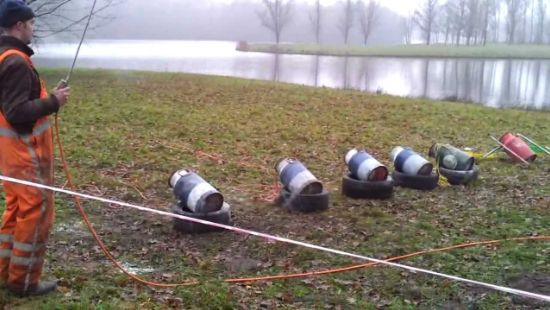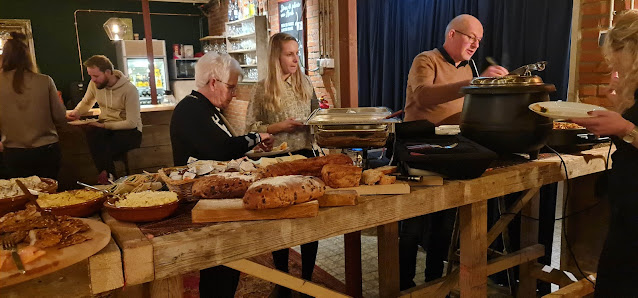Week 6 Sinking Houses/Covid strikes...
Week 6
On the TV during the week
A Consumer program had a segment about houses sinking in the Netherlands - around 800,000 at the moment.
The insurance companies say that it is uninsurable. But some activists are arguing that it should be - and also that it should come under the umbrella of "Global Warming".
One professor argued that it should be the same as in Belgium, where it is insurable, apparently.
He was also fairly scathing of Politicians, saying that they "love a disaster" because they can stand at the site of a flood or other disaster and claim that they will "make it good" and "pay for everything". This is harder to argue for people whose homes are cracking as the clay dries out and subsides - just as much a disaster for them if they have to foot the repair bills..
One chap has been studying the make up of the clay and showed a few samples being dried out in his oven - and how the different types behave when they are dried out - crumbling, cracking, squashing. Causing damage not unlike that in Groningen - caused by gas extraction earthquakes... and which is being compensated by the gas extraction company and the Government.
He also explained that it is mostly in regions where (and when) the building code allowed foundations 40 - 60 cm deep in the clay - which is all well and good if the clay remains wet.
4 days work...
We got around to fixing the spouting after the new New Roof (2nd attempt) was also stuffed up.
The rain has been overshooting the spouting and is soaking the brickwork and door and window frames - not good in a place where even the brickwork will rot eventually - or so it seems.
It took us literally ALL monday morning to figure out the different options...we went to lunch preparing for one rather elaborate solution - but I had a "practical" chat with Janny - and came out after lunch with another idea - the main thing was to make a start and then see if it would work...
The old brackets were sandwiched between two framing timbers (it must have been the way to do it 50 years ago), so we first had to bash them out - getting to the nails with a thin cold chisel.
(The white plastic channel is for the fire alarm cables and a few TV and computer cables. It seemed like a good idea at the time - the fire alarm people had to look up their rules and regulations to see if I was actually allowed to put them outside the building - I had to install it and I couldn't see any other way of getting it done - they eventually came back and said they couldn't find anything against it - so "go ahead". It saved weeks of work!! - but it is in the way a bit now...)
First bit done and tested...
We lost the cold chisel at one stage - it shot through under the roof! - so we had to cut a hole in the very old timbers...
It was all going to be covered and strengthened so having to cut a hole in it wasn't a problem.
The downpipe in the corner was always going to be a problem, so we thought of as many solutions as possible and bought all the bits and pieces - on the understanding that we could take back those we didn't use.
The rainwater runs into our sewage collection tank, so it needs an "s"bend...
Jacoba is registered again...
Internationaal Certificaat voor Pleziervaartuigen (ICP)
The Water Sports Association has been designated by the Ministry of Infrastructure and Water Management as one of the associations in the Netherlands that is authorized to issue the International Certificate for Pleasure Craft (ICP). In the Netherlands there is no registration requirement for most categories of recreational craft. Within Europe, on the other hand, it is mandatory in almost all countries to have an official registration certificate. The ICP was created for the above reasons. With the ICP you can sail with your pleasure craft within a large number of European inland and coastal waters.
Where is it valid? France, Belgium and Germany are included, so it may yet come in handy...for €46,00.
... and I finally got the bill for the registration of my VHF radio - arranged long enough ago that I had almost forgotten that I had yet to pay for it!
... and I finally got the bill for the registration of my VHF radio - arranged long enough ago that I had almost forgotten that I had yet to pay for it!
The price of gas, insulation, subsidies, etc.
On Friday we had an inspection by a representative of WEN (Wijnjewoude Energy Neutral) to advise on the things we can do to reduce our energy bills.
WEN are providing €2000,00 to every household - it makes a start, at least - for any insulation or other energy saving measures.
The chap had a table showing Building Code years - which gave a good indication of the likely construction of our house.
The single most important thing we can do is insulate!
Starting with the cavity walls and then the floor. This is where the year of construction is important. Our cavity is about 6 cm - which can be measured here and there. A year or two later and it may have been reduced to 2 cm - the 6 is better as it allows more insulating material to be pumped in.
His report will include other measures and the steps required to apply for the various subsidies - Federal and Local Governments and the Provincial (Friesland) authorities.
We're getting a visit and a quote for the cavity walls on Monday. They'll be drilling a few holes and poking a camera in to check the measurements and to see if there are any obstructions.
Another chap from nearby Drachten is also coming on Monday to advise on Heat Pumps.
.
These can be fully electric or a combination of gas/electric (Hybrid - where the existing heating system cuts in if the outside temperature gets too cold).
He mentioned a few other types already in use in Friesland. In Heeg (lots of water) there are systems using the canal water to provide the initial heat. Through a fairly elaborate system of pipes the water is directed to the heat pump which then puts it under pressure and then the condensation process releases even more heat.
The following would apply to our house where heat would be drawn from underground...
Heat is present in the earth's soil. This heat comes from both the sun and the magma that is deep in the earth. We call this heat geothermal heat. When we now install an underground pipe network, this geothermal heat can be used to heat the water in the pipe network. However, the temperature of this is not yet high enough to heat the house, which is why the pump raises the temperature further with the help of a compressor, evaporator and condenser. With the help of a heat exchanger, the heat is finally released to the central heating system in the house. The heat pump uses a (small) amount of electricity for this process.
We rather like this idea because we have enough land for it. It has to be 1.5 metres deep (Any deeper would require a permit).
A vertical system could be up to 150 metres deep - it is much more efficient and reliable but drilling is expensive and does require a permit.
Ben in Capetown...
...sending us photos to remind us of warmer climes...
And we're having an unexpected weekend off: all our personnel have Covid or have been in close contact and have to isolate. So Janny had to contact all the parents to call the weekend off - first time in 14 years, apart from the early Covid measures. I don't think there'll be any compensation this time around.

























Comments
Post a Comment